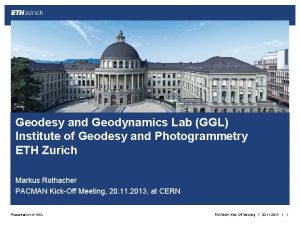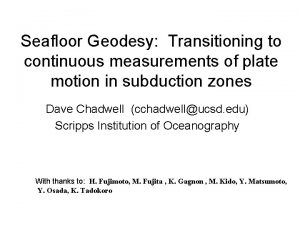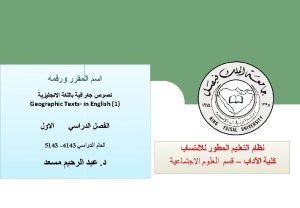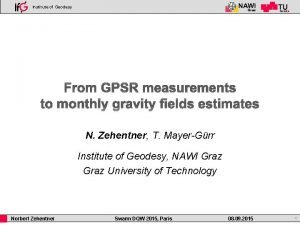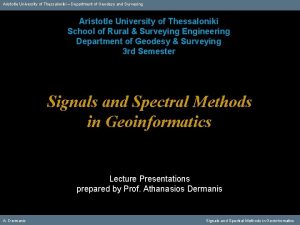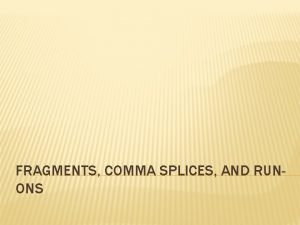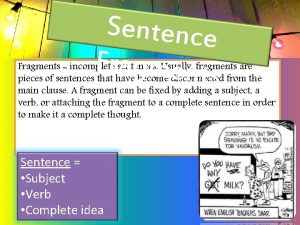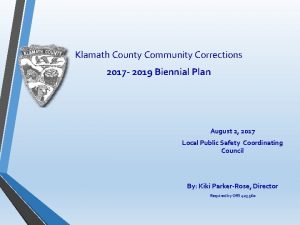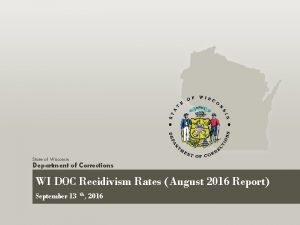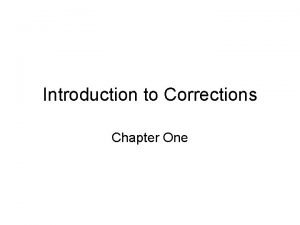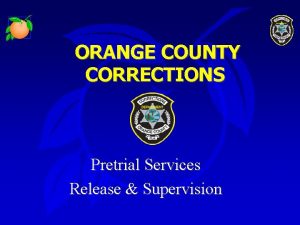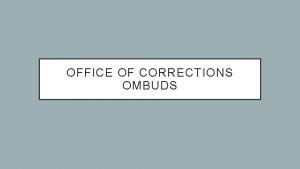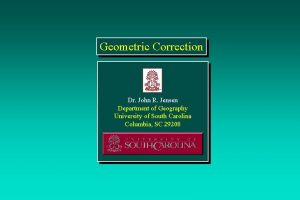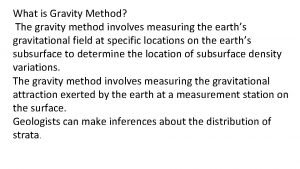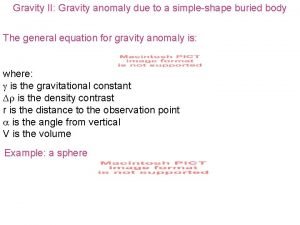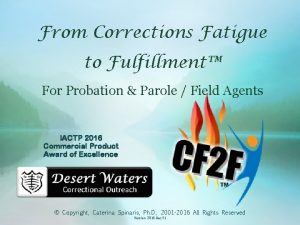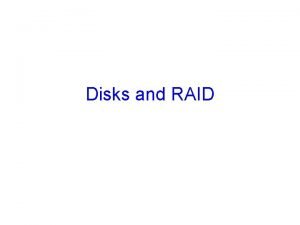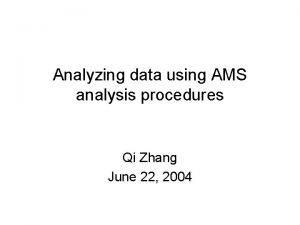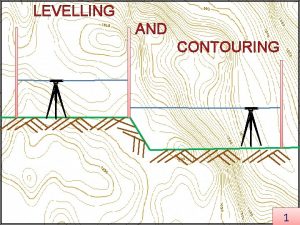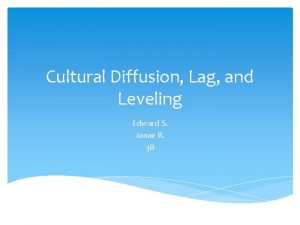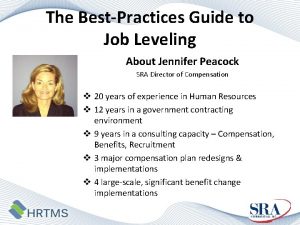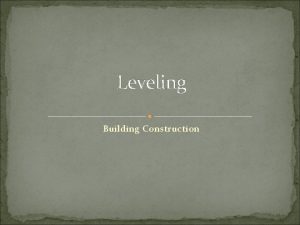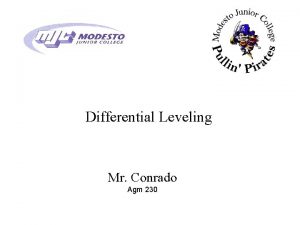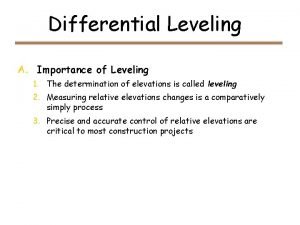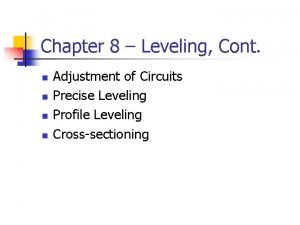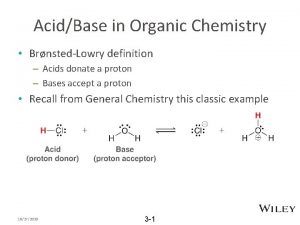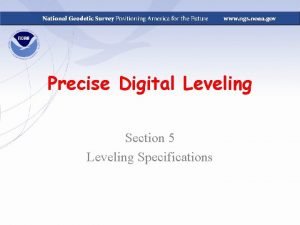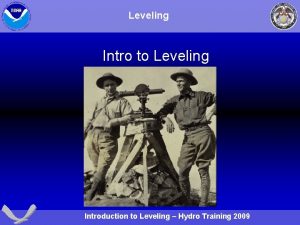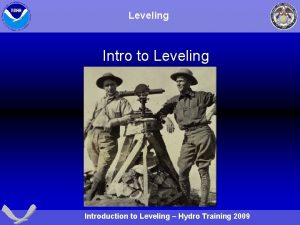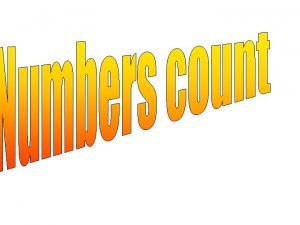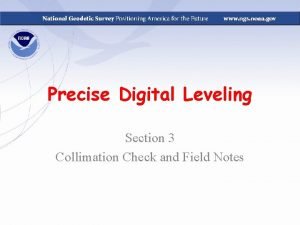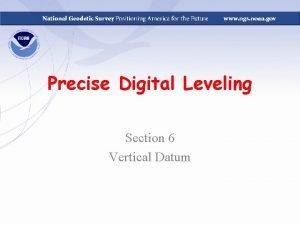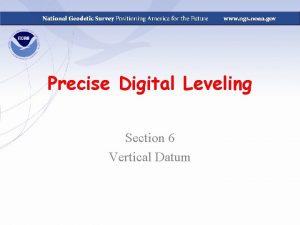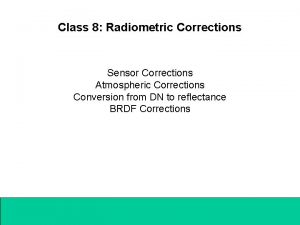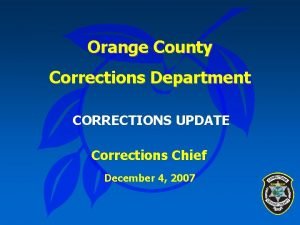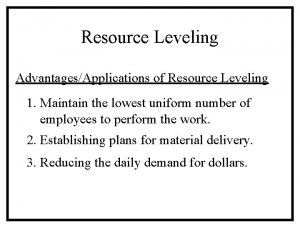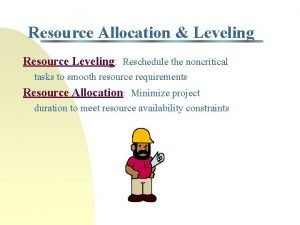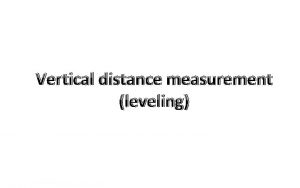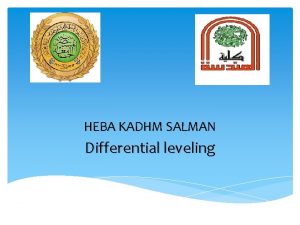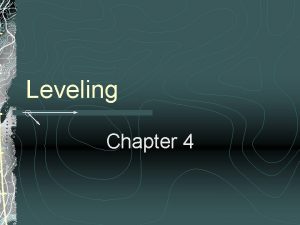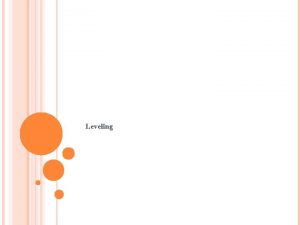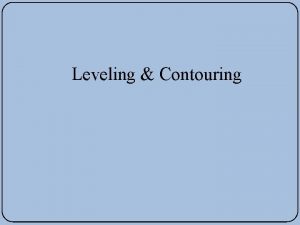Precise Digital Leveling Section 4 Geodesy and Corrections








































![Orthometric Correction Co=-2 hα·sin 2ρ[1+(α– 2β/α)cos 2ρ]dρ h = average height of section α Orthometric Correction Co=-2 hα·sin 2ρ[1+(α– 2β/α)cos 2ρ]dρ h = average height of section α](https://slidetodoc.com/presentation_image/22d2782463cf4d3f234c3de8508ce821/image-41.jpg)








- Slides: 49

Precise Digital Leveling Section 4 Geodesy and Corrections for Leveling

Leveled Height Differences B A Topography C

GRACE Gravity Model 01 - Released July 2003 Image credit: University of Texas Center for Space Research and NASA

The Geoid Geopotential Surfaces Ellipsoid Surface Gravity Vector The relationships between the ellipsoid surface (solid red), various geopotential surfaces (dashed blue), and the geoid (solid blue). The geoid exists approximately at mean sea level (MSL). Not shown is the actual surface of the earth, which coincides with MSL but is generally above the geoid.

Level Surfaces and Orthometric Heights Level Surfaces P h’se t r Eaurfac S WP Plumb Line Mean Sea Level PO Ocean “Geoid” WO Level Surface = Equipotential Surface (W) Geopotential Number (CP) = WP -WO H (Orthometric Height) = Distance along plumb line (PO to P) Area of High Density Rock Area of Low Density Rock


Vertical Datum Relationships 3 -D Datums WGS 84, NAD 83 (86) NAVD 88, NGVD 29 Orthometric Datums MHHW, MTL, DTL, MLW, MLLW Tidal Datums

Corrections Applied to NGS’ Leveling Observations

Curvature Error, C, Where the Line of Sight Is not Parallel to an Equipotential Surface Cancels if SB = SF SB Horizontal CB SF Line of Sight Equipotential Surface Direction of Gravity CF

Rod A Shimmer Rod B Shorten setup distances – instrument to rod Balance setups – minimize differences Observe over similar surfaces

Crossing a Highway Avoid if Possible Minimize Dissimilar Backsight Foresight Observing Conditions

B 1 cos P 1 Rod 2 Rod 1 F 1 cos P 2 B 2 cos P 2 Systematic effect of plumbing error (and scale errors) is small on flat terrain, since B 1 ≈ F 2 and F 1 ≈ B 2 F 2 cos P 1

Rod 1 Rod 2 Rod 1 F 2 cos P 1 B 2 cos P 2 F 1 cos P 2 B 1 cos P 1 Systematic effect of plumbing error (and scale errors) accumulates on sloping terrain, since B 1 ≠ F 2 and F 1 ≠ B 2



Rod Scale Correction Cr = De D = observed Δelevation for the section in meters e = average length excess of the rod pair in mm/m Length excess is determined in rod calibration process

Rod Calibration – Invar to Bottom Reference Plate

Calibration Report SLAC Metrology Laboratory

Laval University (ULAVAL)

Technical University in Munich (TUM)

Stanford Linear Accelerator Center (SLAC)

Stanford Linear Accelerator Center (SLAC) Additional Notes

Critical Distances: It is already well known in the metrology community that digital levels give inaccurate results at certain distances. Therefore the expansion of these distances have to be evaluated to avoid them during the field measurements. As an example, measurements at and around a critical distance of the DNA 03 are shown below.

Hence Rule – Keep all three crosshairs on Invar!

Keep all three crosshairs on Invar!

Maintain Line of Sight 0. 5 m Above Ground Rod Must be ≥ 0. 5 m

RI-LOAD Documentation


Rod Temperature Correction Ct = ( tm – ts ) D · CE tm = mean observed temperature of Invar strip ts = standardization temperature of Invar strip D = observed Δelevation between the bench marks CE = mean coefficient of thermal expansion

Refraction Correction (thermistors) R = -5 -10 2 γ(S/50) δ · D S = distance (instrument to rod) in meters γ = 70 δ = observed temperature difference between probes at each setup D = Δelevation for the setup in units of half-cm

Refraction Error, r, Does Not Cancel on Sloping Terrain Since r. B ≠ r. F, even if SB = SF Cool r. F r. B Warm SB SF

NGS Aspirated Temperature Probes

Rigid Leg Tripod With Thermister Equipment

Refraction Correction (predicted) R = -10 -5 γ{S/[(2 n)(50)}2 δ · d · W S = distance (instrument to rod) in meters γ = 70 n = number of setups δ = “predicted” temp. diff. d = Δelevation for the setup in units of half-cm W = weather factor based upon “sun code” where it equals 0. 5 for totally overcast, 1. 0 for 50% cloudy, 1. 5 for 100% sunny Correction not used when thermistors are used!

Time Zones U. S. NAVY TIME ZONE DESIGNATIONS STANDARD TIME Atlantic AST Eastern EST Central CST Mountain MST Pacific PST Yukon YST AK/HI HST DAYLIGHT TIME MERIDIAN Eastern EDT 60 W Central CDT 75 W Mountain MDT 90 W Pacific PDT 105 W Yukon YDT 120 W AK/HI HDT 135 W Bering BDT 150 W TIME ZONE U. S. NAVY DESCRIP’N DESIGNATION +4 Q (Quebec) +5 R (Romeo) +6 S (Sierra) +7 T (Tango) +8 U (Uniform) +9 V (Victor) +10 W (Whiskey)

Astronomic Correction Ca = 0. 7 · Ks s = section length K = tan εm cos(Am – α) + tan εs cos(As – α) where As = azimuth of the sun; Am = azimuth of the moon; α = azimuth of section (Δλ/Δθ of adjacent BMs) 0. 7 because the earth is elastic

One of Several Corrections Applied to Precise Leveling Route є a S um Refer e Tid m axi M Eq ib l i u ence ium r S Effect, a, of tidal deflection, є, on a section of length and direction S Surfa ce N

Level Collimation Correction Cc = - (e·SDS) e = collimation error in radians x 1000 or mm/m SDS = accumulated difference in sight lengths for the section in meters

Effect of Collimation Error, α S(tan α) α Line of Sight Horizontal S Direction of Gravity

Consistent Collimation Error Cancels In Balanced Setup Since SB = SF α α SB SF Direction of Gravity
![Orthometric Correction Co2 hαsin 2ρ1α 2βαcos 2ρdρ h average height of section α Orthometric Correction Co=-2 hα·sin 2ρ[1+(α– 2β/α)cos 2ρ]dρ h = average height of section α](https://slidetodoc.com/presentation_image/22d2782463cf4d3f234c3de8508ce821/image-41.jpg)
Orthometric Correction Co=-2 hα·sin 2ρ[1+(α– 2β/α)cos 2ρ]dρ h = average height of section α = 0. 002644; β = 0. 000007 ρ = average latitude of the section dρ = latitude difference between the beginning and end points of the section Correction not needed when geopotential numbers are used!

All Heights Based on Geopotential Number (CP) The geopotential number is the potential energy difference between two points g = local gravity; WO = potential at datum (geoid); WP = potential at point Why use Geopotential Number? - because if the GPN for two points are equal they are at the same potential and water will not flow between them

Geopotential Number O = one point on the geoid A = another point on the geoid connected to “O” by precise leveling dn = Δelevation between the Bench Marks g = average value of actual gravity between successive Bench Marks, but to look up g we need θ and λ, and we need to know the number of setups since we are integrating

Geopotential to Orthometric H = C/(g + 0. 0424 H 0) C = the estimated geopotential number in gpu g = the gravity value at the benchmark in gals H = the orthometric height in kilometers

Heights Based on Geopotential Number (C) • Normal Height (NGVD 29) H* = C / – = Average normal gravity along plumb line dyn • Dynamic Height (IGLD 55, 85) H = C / 45 – 45 = Normal gravity at 45° latitude • Orthometric Height H = C / g – g = Average gravity along the plumb line • Helmert Height (NAVD 88) H = C / (g + 0. 0424 H 0) – g = Surface gravity measurement (mgals)

Idiosyncrasies & Caveats • θ and λ observables are stored in description file – What happens to observations when you create a TBM? • The gravity file is in the NAD 27 datum • Temperatures are taken at many places and times – Thermistor probes at each instrument setup – Thermometers at each bench mark – Thermometers on each rod • Wind and sun codes are a very important fallback

Idiosyncrasies & Caveats (Continued) • Tables of constants are tabulated in time and position so time, time zone, and datum are very important • When data are loaded to the data base they are supposed to be statistically free of biases and blunders. • Field specifications and procedures are designed to trap biases and blunders in the field

“Phase 1” Data Office Abstract

Setup of Leveling, Δh = B – F and S = SB + SF Rod 1 Rod 2 Foresight Backsight F B Δh SB S SF
 Geodesy and geomatics engineering
Geodesy and geomatics engineering Institute of geodesy and photogrammetry
Institute of geodesy and photogrammetry Geodesy
Geodesy Branches of geodesy
Branches of geodesy Space geodesy facility
Space geodesy facility Geodesy
Geodesy Geodesy
Geodesy Define corrections in criminal justice
Define corrections in criminal justice Comma splice examples and corrections
Comma splice examples and corrections Which of the following is a sentence fragment marina
Which of the following is a sentence fragment marina Criminal thinking tactics
Criminal thinking tactics Law public safety corrections and security answer key
Law public safety corrections and security answer key Accounting changes and error corrections
Accounting changes and error corrections Current and future issues in corrections
Current and future issues in corrections Larch corrections center
Larch corrections center Klamath county parole and probation
Klamath county parole and probation Florida department of corrections mission statement
Florida department of corrections mission statement Department of corrections wisconsin
Department of corrections wisconsin Intro to corrections
Intro to corrections Orange county community corrections
Orange county community corrections Office of corrections ombuds
Office of corrections ombuds Geometric corrections
Geometric corrections What is gravity method
What is gravity method Gravity corrections
Gravity corrections Corrections fatigue
Corrections fatigue Debye huckel equation
Debye huckel equation Essay corrections
Essay corrections Unraid write corrections to parity
Unraid write corrections to parity Fif airbeam
Fif airbeam Resource loading chart example
Resource loading chart example Inverted staff reading
Inverted staff reading Tacheometric method of contouring
Tacheometric method of contouring How are globalization and cultural leveling related
How are globalization and cultural leveling related Digital markets and digital goods
Digital markets and digital goods Hrtms market share
Hrtms market share Close level
Close level Profile leveling in surveying
Profile leveling in surveying Ario practice problems
Ario practice problems Leveling in construction
Leveling in construction Eccentric leveling lugs
Eccentric leveling lugs Differential leveling field notes
Differential leveling field notes Differential leveling
Differential leveling Resource leveling is the approach to even out the peaks of
Resource leveling is the approach to even out the peaks of Cont nn
Cont nn Leveling effect organic chemistry
Leveling effect organic chemistry Ario organic chemistry
Ario organic chemistry Ms project resource leveling
Ms project resource leveling Horizontal line
Horizontal line Which of the following is a strategy to promote leveling?
Which of the following is a strategy to promote leveling? Vial datum
Vial datum

